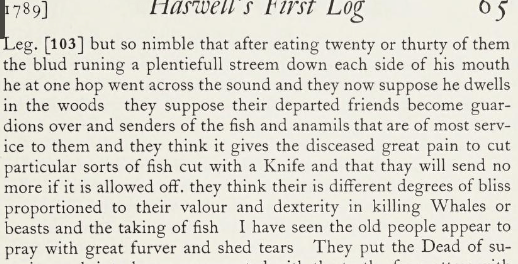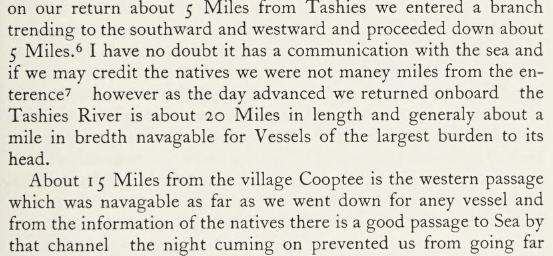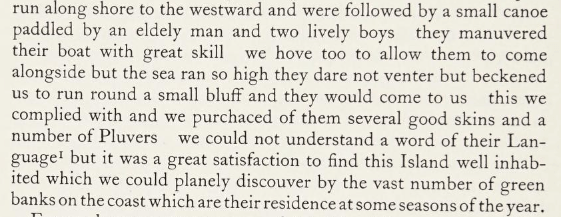Howay [Haswell, Boit, Hoskins] “Voyages of the Columbia” (Part 1B of 5)
Continuing our research on the earliest Native contacts with Newcomers on the Pacific Northwest coast is BC judge F.W. Howay’s “Voyages of the “Columbia” to the Northwest coast, 1787-1790 and 1790-1793” (Portland, OR : Oregon Historical Society Press, 1990).
[Part 1A here.]
[Part 1C here.]
Here’s more from Haswell’s narrative of the first voyage of the Columbia to these shores, 1788-1789:

Robert Haswell (image credit: Wikipedia)
Part 1B:
Still among the Nuuchahnulth people of Vancouver Island, pages 64-65, about Native religion, always among the most potentially convincing evidence of fairly sophisticated communication with Newcomers:


Religion and method of burieng ther dead the[y] pay great adoration to the Sun they believe in a supreem god and a Deavil they have several strange stories of this strange monster they say they were doing some bad thing on the beach in some past ages when the dredfull fellow made his appearance they represent him as Black with fiery eyes he is of an enormous size and has but one Leg. but so nimble that after eating twenty or thurty of them the blud runing a plentiefull streem down each side of his mouth he at one hop went across the sound and they now suppose he dwells in the woods they suppose their departed friends become guardions over and senders of the fish and anamils that are of most service to them and they think it gives the disceased great pain to cut particular sorts of fish cut with a Knife and that thay will send no more if it is allowed off. they think their is different degrees of bliss proportioned to their valour and dexterity in killing Whales or beasts and the taking of fish I have seen the old people appear to pray with great furver and shed tears
Quite a lot of additional detailed cultural information follows, implying that both the writer’s stated familiarity with Captain Cook’s narrative and his time spent here have contributed to a pretty good acquaintance with Native life.
Page 66 has the narrator being told some information about mourning customs by Native people:

…we were amazed to [hear] a Lowd and most pitious moan on inquiering the cause I was informed a Canoe loaded with herrins had upset and that a Mischimmee [masčim ‘commoner’] or Labouring man was drownded and that it was the Women condoling with the Widow and moaning over the corps for they say they revear the memery of a person who dies in so Laudable a persute.
Page 67 — March 19 & 20, 1789, one man’s chosen name:

…a Chief from the Village A’howset that called himself Captain Hannah [this man is noted below also]
Page 71, in Ditidaht territory, March 29, 1789:

at ½ past 9 we saw a canoe at a great Distance they approached us with great caution and when within hearing made maney exclamations of Friendship before they ventured nigh we were glad to find they spoke a dialect of the Nootka Language.
Page 72, apparently somewhere in Makah territory, March 31, 1789, one of several reports from Indigenous folks about chiefs trying to corner the trade:

the canoe came mearly alongside they had no skins and told us their were none up the Straits but that they Chief Tatooth of Clahaset had purchaced them all they offer’d their own manufactored blankets which weir realy curious and Children for sale.
Page 74, at Neah Bay in Makah country:

they told us the village abrest of which we anchored was named Nee’ah and I have no doubt on the other side of the Island tolerable good anchorage might be found of these people we bought some good Halibut, I was not much prejaused in the favour of these people tho’ they spoke Nootka Language but they wanted that harmless inofencive counteness so agreable in our Northern friends. [i.e. the Nuučaan’uɬ]
Page 77, in the vicinity of Clayoquot (the modern Tofino, BC area of Vancouver Island):

at hearing a very suden and Loud shout and seeing allmost every Boddy runing from the village to their canoes I was soon eased from my suspence by my Friend Hannah [see above] who told me Wickananish had struck a Whale and that all the Villagers where going to his asistance
Same area, same time, pages 77-78:


I had maney invitations to visate and partake with them but with this I did not comply on my Return onboard I made particular inquieries relative to their customs in whaling. they told me the first Whale that was killed in a season it was their custom to make a sacrefise of one of their slaves the corps they lay besid a large pece of the Whales head adorned with eagles feathers after it has lay’d their a sertain time they put it in a Box as usual they say it is particularly pleasing to their Deaty to adorn a Whale with Eagles fethers for they suppose thunder is caused in conflicts between that Bird and fish that an Egle of enormious size takes the Whale high in the air and when it falls causes the noise Thunder, on their Whaling excurtions they frequently cut their tongues and paint themselvs with the blud that the Whale may not be afraid of them and run from them or they afraid of it they have maney other superstisious Id[e]as relative to this fish
Page 79, April 13 of 1789, thought to be near Port Effingham on Village Island, BC, another chief trying to dominate the trade:

a great maney of the natives were round us but we were disapointed in finding they had no skins they told us Wickananish had been down there and purchaced all they had.
Page 81, April 19 of 1789, near Tatoosh Island, Makah territory, a promise to trade in the near future:

while in this situation the Chief with 2 canoes came off and sold upwards of 20 prime Skins and they departed well pleased with recieving 5 Chizels each and promised to bring a great number more the next day…
Page 83, Tahsis area of Vancouver Island, April 30, 1789, geographical information from local people:

on our return about 5 Miles from Tashies we entered a branch trending to the southward and westward and proceeded down about 5 Miles. I have no doubt it has a communication with the sea and if we may credit the natives we were not maney miles from the enterence however as the day advanced we returned onboard the Tashies River is about 20 Miles in length and generaly about a mile in bredth navagable for Vessels of the largest burden to its head.
About 15 Miles from the village Cooptee is the western passage which was navagable as far as we went down for aney vessel and from the information of the natives there is a good passage to Sea by that channel
Page 85, approximately May 1 of 1789, Nasparti Inlet, Vancouver Island, a local place name is learned:

On thursday the wind increesed to a gale and tho’ we had beat to the westward of woody point we were driven by violent advars winds again into hope bay and on friday morning we stood into a place called by the natives Chickleset where there is every appearance of a good harbour
Page 87, in the vicinity of Milbanke Sound on the BC mainland, presumably in Haíɫzaqv a.k.a. Heiltsuk (Northern Wakashan)-speaking territory, May of 1789, the mariners notice that they’ve found a different language group:

Their Language differed intierly from the natives we had last left, and Iron was the only article of trade held in high estimation by them
On page 88, Haswell notes, probably correctly in Howay’s estimation, that the Columbia seems to be the first “Europeans” ever seen by these Haíɫzaqv people.
Page 90, apparently near modern Prince Rupert, BC (Ts’msyan a.k.a. Coast Tsimshian territory), in May of 1789, the crew members think they understand the message being put to them by these speakers of yet another newly encountered language:

on sounding the harbour I found good anchorage in every part of it the natives that came off to us had with them a fue otter skins these people were on a hunting excurtion and made us understand they were at a great distance from their village they were very anxious that we should tarrey here two or three days supposing they wished to inform the rest of their tribe of our arrival that they might bring their skins for sale they departed making expressive Jestures to inform us they would return in a fue days
But a few sentences later on that page, Haswell reports,
it was not till the 19th that our Friends returned and much to our disappointment they had been to Kill the otters insted of informing the tribe of our arrival they had ten Otters in the boat several of them yet warm with life”
Nevertheless on page 91, in the area of the modern BC-Alaska marine border (Dixon Entrance or Clarence Strait), which I would take to be Coast Tsimshian territory the crew again suppose they understand what the locals are trying to say:

we observed a canoe following us with grate haste shouting loudly for us to return. as soon as we saw them we hove about and stood inshore they soon came alongside and were very anxious for us to go to their village making signs that they had vast abundance of skins tho’ they had none in their Canoe they were armed with iron barbed speers and wished one of us to go with them onshore a Chief offering to rema[i]n onboard as an hostage for our safe return.
Page 92 has what Howay calls “the first meeting of the Americans with the Haidas”, another newly encountered language group, in Haida Gwaii:

…a small canoe paddled by an elderly man and two lively boys they manuvered their boat with great skill we hove too to allow them to come alongside but the sea ran so high they dare not venter but beckened us to run round a small bluff and they would come to us this we complied with and we purchaced of them several good skins and a number of Pluvers we could not understand a word of their Language but it was a great satisfaction to find this Island well inhabited which we could planely discouver by the vast number of green banks on the coast which are their residence at some seasons of the year.
Pages 95-96 also in Haida Gwaii, end of May to beginning of June, 1789:


…it was the [ ] before we saw Washingtons Island and at 6 PM a vast number of Natives men Women and Children came off and brought with them several sea otter skins we understood of them that their was a large tribe not far off the weather was very thick hazey and we were but little distance from the land We soon saw their village from which they lanched twenty or thurty very large canoes and came off in great perade padleing off swiftly and singing a very agreable air. 1789. June. of those people were purchaced to the amount of two hundred skins in a very fue moments for one chizle each. we bought all the skins they appeared to have by 10 in the evening when they returned to their Village for the night no doubt intending to bring off more in the morning but we did not stop but stood on to the southward the natives called their villag Custa it is situated in a sandy bay on the NW end of the Island their Chiefs name is Cuneah and appears to be a very good old Fellow
Pages 97-98, Houston Stewart Channel in Haida Gwaii:


A brisk trade was soon set on foot by Coya the Chief who bartered for all his Subjects, and a number of Sea Otter skins were purchaced before night. Iron was of far less value with them than with those natives we were last with cloathing was most in demand these people had been visited by several navigaters they spoke distinctly of Colinnet [Colnett] and Dunkin [Duncan] and they brought a pece of Paper that Informed us the NW American Schooner had been here May the 24th last. This Sound was honoured with the name of Barrel sound in honour of our owner duering our tarrey hear I landed to take an excurtion in the woods when I met with a fortified Rock which I suppose in case of invasion is their place of refuge it was purpindicular about forty feet high the top was flat about twenty yards wide it was inacessable on all sides except by an oald rotten lader that was erected by its side this fort they call Touts [t’awts’i ‘fort’] and when their northern neghbours come to molest them they put their Women and Children up thare while they fight the battle they say it is their custom to eat their vanquished enemies and said it was excellent food.
Howay keeps adding footnotes to the effect that PNW Coast cannibalism was a persistent rumour among the Euro-Americans, but that it’s not documented in the ethnographic record. So, when these sailors say that Native people “told” them they eat human flesh…what shall we think?
Coming next: a very important early vocabulary of Nuuchahnulth.

Pingback: Howay [Haswell, Boit, Hoskins] “Voyages of the Columbia” (Part 1C of 5) | Chinook Jargon
Pingback: Howay [Haswell, Boit, Hoskins] “Voyages of the Columbia” (Part 1A of 5) | Chinook Jargon